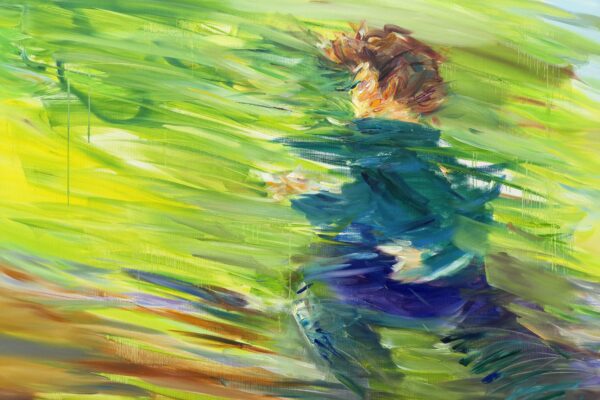Moon Jinyoung Solo Exhibition
2024. 6. 17 - 6. 22 | [GALLERIES] Gallery Q
문진영

문진영, “해체”가 서있는 경계, 마지, 한지, 안피지, 91x91cm
작가는 한 장의 종이 화면을 뜯어 헤지고 잘라서 분리하는 방식으로 작업해 나간다. “해체解体(deconstruction)”를 소재로 한 작업이다. 작업이 보여주는 “해체”는 특징이 있다. 이 작업에서 ”해체”는 찢겨져 갈라진다는 상태로 드러나는 과정 가운데 필연적으로 “질서”를 만들어 내고, “질서” 또한 “해체”라는 갈라짐과 분리됨을 통해 그 실체가 드러나게 된다. 상반된 성질의 것이 동전의 양면과 같이 상호공존의 상태로 존재 할 수 밖에 없는 아이러니를 가지고 있고, 작가는 양면성을 실마리로 작업을 펼쳐진다고 할 수 있다.
화면은 이렇듯 해체라는 추상적 상태를 화면에 하나의 양태로 가져와 커뮤니케이션하는 과정을 수행적으로 보여준 것이다. 작가에게 문인화의 ”의경“에서 보이는 미학적 태도가 작업의 수행적 행위를 연결해 가는 실마리가 되었다고 한다. 작가는 ”의경“의 “대상과 나와의 비가시적 경계에서, 내 의식에 그려지는 ‘그 무엇’을 이라는 해석을 두고, 나의 의식이 생기는 대상과의 비가시적 경계에 주목한다. 작업의 표면에서 보이는 ”해체“와”질서“의 가시적 경계 넘어서 , ”지금 나에게 실재하는 문제의 실체-해체“라는 문제의 상태를 이 작업을 통해 의식으로 직면해 가는 방식으로 작업을 진행한 것이다.

문진영, 해체된 것이 맞이할 시적 순간, 마지, 한지, 안피지, 금박, 130x130cm
이런 과정에서 나온 형태들은 기존의 기하학적 형태들과는 다르며, 질서의 지향성과 해체의 지향성이 마치 의지를 갖은 인격체인 것처럼 힘의 대결을 통해 자기조직화를 이루는 듯한 미완의 형태와 같이 보인다. 작품에서의 이러한 양태들을 연결 지어 보거나 각자가 재구성해서 감상하는 것은 관람자의 몫이다. 이 과정에서 관람자에게도 의경의 의식이 발동되길 바라며, 저마다의 의식에 작용하는 미의식의 잠재적 의미가 드러날 것을 기대한다.

문진영, 두사람 -말레비치에 의해 남겨진 터 위에서 > 시리즈2, 마지, 합성수지, 한지, 안피지, 100x100cm
작가는 2004년 한국 성균관 대학 미술 연구과 졸업 후 동양의 전통 재료 기법을 배우기 위해 일본으로 건너간다. 2006년부터 도쿄 예술대학 대학원 미술 연구과에 입학, 문화재 보존학과에서 석사와박사과정을 졸업하고, 이후 도쿄 예술대학 대학원 미술 연구과에서 강사와 연구원으로 근무하면서 창작 활동을 병행한다. 당시, 작가는 벽화복원 연구에 종사하면서, 전통문화에 근거한 인간의 고유성에 의한 표현과 세계에 대한 태도에 관한 문제의식을 심화시키는 계기를 가지게 된다. 또한 2011년 3월 11일 대지진을 계기로 이러한 문제 의식을 전면화한 추상화 제작에 임한다.
그녀는 전통 재료기법에 대한 연구를 다년간 해왔지만 오히려 전통적인 재료기법을 온전히 따르기보다 기법을 재해석하는 과정이 필요했다. 작가 관심을 갖은 것은 특정 기법들이 담아내려했던 미학이였고, 특히 한국의 자생적인 미학이였기 때문이다. 본 작업에서도 종이를 붙이기 위해 사용했던 “쿠이사키”라는 전통기법이 오히려 본 작업에서는 “해체”의 양상을 드러내기 위해 역설적으로 사용되었다 .

문진영, 두사람 -말레비치에 의해 남겨진 터 위에서 >시리즈1, 마지, 한지, 안피지, 100x100cm
본 전시를 통해 대표 시리즈인 “해채된 것들이 맞이할 시적 순간”을 포함, 순수 추상화의 길을 연 카지미르 말레비치(kazimir severinovich Malevich1879-1935) 가 1915년 <0.10> 전시회에서 발표했던 [Black square]작품과 1981작 [White on White]을 작품을 오마주한 “두 사람- 말레비치에 의해 감겨진 터 위에서” 및 이외 다수의 작품을 선보일 예정이다.
오마주 작품의 “두 사람-”은 해체와 질서의 힘이 의인화된 제목이다. ”말레비치에 의해 남겨진 터-“는 말레비치에 의해 “無・zero“의 형식이이라는 ”물질 자체“로 무화되어 남겨진 평면에서 부터 다시 새로운 지향점을 둔 회화의 본질을 찾아가고자 하는 의미를 갖는다.
이번 전시를 통해 작가는 포스트모던 시대의 해체라는 현상으로 다가오는 세계 모습의 양가성, 그리고 그와 관계 맺는 것이 무엇인지를 물으며, 본질 추구라는 모더니티의 회화적 과제를 안고 있는 추상회화 안에서 어떻게 물음을 던지고 있는지 보는 것이 숨겨진 관람의 포인트라 하겠다.
Gallery Q Tokyo
1-14-12-3F Ginza Chuo-ku Tokyo Japan
+81-3-3535-2524
[GALLERIES] Gallery Q
- Dates
- 2024. 6. 17 - 6. 22











